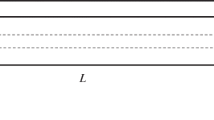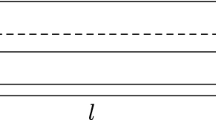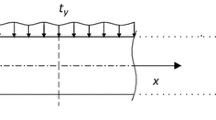Abstract
A version of the refined nonclassical theory of thin beams whose thickness is comparable with the scale characteristic of the material structure is constructed on the basis of the gradient theory of elasticity which, in contrast to the classical theory, contains some additional physical characteristics depending on the structure scale parameters and is therefore most appropriate for modeling the strains of scale-dependent systems. The fundamental conditions for the well-posedness of the gradient theories are obtained for the first time, and it is shown that some of the known applied gradient theories do not generally satisfy the well-posedness criterion. A version of the well-posed gradient strain theory which satisfies the symmetry condition is proposed. The well-posed gradient theory is then used to implement the method of kinematic hypotheses for constructing a refined theory of scale-dependent beams. The equilibrium equations of the refined theory of scale-dependent Timoshenko and Bernoulli beams are obtained. It is shown that the scale effects are localized near the beam ends, and therefore, taking the scale effects into account does not give any correction to the bending rigidity of long beams as noted in the previously published papers dealing with the scale-dependent beams.
Similar content being viewed by others
References
S. Kakunai, J. Masaki, R. Kuroda, et al., “Measurement of Apparent Young’s Modulus in the Bending of Cantilever Beam by Heterodyne Holographic Interferometry,” Exp. Mech. 25(4), 408–412 (1985).
D. C. C. Lam, F. Yang, A. C. M. Chong, et al., “Experiments and Theory in Strain Gradient Elasticity,” J. Mech. Phys. Solids 51, 1477–1508 (2003).
A. W. McFarland and J. S. Colton, “Role of Material Microstructure in Plate Stiffness with Relevance to Microcantilever Sensors,” J. Micromech. Microeng. 15(5), 1060–1067 (2005).
F. Yang, A. C. M. Chong, D. C. C. Lam, and P. Tong, “Couple Stress Based Strain Gradient Theory for Elasticity,” Int. J. Solids Struct. 39, 2731–2743 (2002).
C. M. Wang, Y. Y. Zhang, and X. Q. He, “Vibration of Nonlocal Timoshenko Beams,” Nanotech. 18, 105401 (2007).
H. M. Ma, X.-L. Gao, and J. N. Reddy, “A Microstructure-Dependent Timoshenko Beam Model Based on a Modified Couple Stress Theory,” J. Mech. Phys. Solids 56(12), 3379–3391 (2008).
H. M. Ma, X.-L. Gao, and J. N. Reddy, “A Non-Classical Plate Model Based on a Modified Couple Stress Theory,” Acta Mech. 220(1–4), 217–235 (2011).
R. D. Mindlin, “Micro-Structure in Linear Elasticity,” Arch. Rat. Mech. Anal. 16(1), 51–77 (1964).
R. D. Mindlin and N. N. Eshel, “On First Strain-Gradient Theories in Linear Elasticity,” Int. J. Solids Struct. 4(1), 109–124 (1968).
X.-L. Gao and S. K. Park, “Variational Formulation of a Simplified Strain Gradient Elasticity Theory and Its Application to a Pressurized Thick-Walled Cylinder Problem,” Int. J. Solids Struct. 44, 7486–7499 (2007).
S. Lurie, D. Volkov-Bogorodskii, A. Leontiev, and E. Aifantis, “Eshelby’s Inclusion Problem in the Gradient Theory of Elasticity. Applications to Composite Materials,” Int. J. Engng Sci. 49, 1517–1525 (2011).
D. B. Volkov-Bogorodskii and S. A. Lurie, “Eshelby Integral Formulas in Gradient Elasticity,” Izv. Akad. Nauk.Mekh. Tverd. Tela, No. 4, 182–192 (2010) [Mech. Solids (Engl. Transl.) 45 (4), 648–656 (2010)].
V. V. Vasiliev and S. A. Lurie, “To the Problem of Construction of Nonclassical Theories of Plates,” Izv. Akad. Nauk SSSR. Mekh. Tverd. Tela, No. 2, 158–167 (1990) [Mech. Solids (Engl. Transl.)].
V. V. Vasiliev and S. A. Lurie, “On Refined Theories of Beams, Plates, and Shells,” J. Compos. Mater. 26(4), 546–557 (1992).
P. A. Belov and S. A. Lurie, “Theory of Ideal Adhesion Interactions,” Mekh. Komp. Mater. Konstruktsii 13(4), 45–56 (2007) [J. Comp. Mech. Design (Engl. Transl.)].
S. A. Lurie and N. P. Tuchkova, “Continual Models of Adhesion for Deformable Solids and Media with Nanostructures,” Kompoz. Nanostrukt. 2(2), 25–43 (2009).
S. A. Lurie, P. A. Belov, and Yu. O. Solyaev, “Adhesion Interactions in Continuum Mechanics,” Mat. Model. Sist. Prots. 16, 75–85 (2008).
S. A. Lurie, D. B. Volkov-Bogorodskii, V. I. Zubov, and N. P. Tuchkova, “Advanced Theoretical and Numerical Multiscale Modeling of Cohesion/Adhesion Interactions in Continuum Mechanics and Its Applications for Filled Nanocomposites,” Int. J. Comp. Mater. 45(3), 709–714 (2009).
Author information
Authors and Affiliations
Corresponding author
Additional information
Original Russian Text © S.A. Lurie, E.L. Kuznetsova, L.N. Rabinskii, E.I. Popova, 2015, published in Izvestiya Akademii Nauk. Mekhanika Tverdogo Tela, 2015, No. 2, pp. 30–43.
About this article
Cite this article
Lurie, S.A., Kuznetsova, E.L., Rabinskii, L.N. et al. Refined gradient theory of scale-dependent superthin rods. Mech. Solids 50, 135–146 (2015). https://doi.org/10.3103/S002565441502003X
Received:
Published:
Issue Date:
DOI: https://doi.org/10.3103/S002565441502003X




